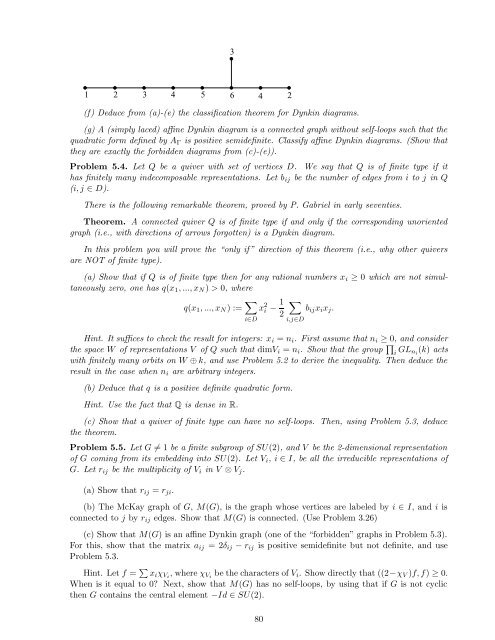Lecture notes for Introduction to Representation Theory
Lecture notes for Introduction to Representation Theory
Lecture notes for Introduction to Representation Theory
Create successful ePaper yourself
Turn your PDF publications into a flip-book with our unique Google optimized e-Paper software.
3<br />
1 2 3 4 5 6 4 2<br />
(f) Deduce from (a)-(e) the classification theorem <strong>for</strong> Dynkin diagrams.<br />
(g) A (simply laced) affine Dynkin diagram is a connected graph without self-loops such that the<br />
quadratic <strong>for</strong>m defined by A is positive semidefinite. Classify affine Dynkin diagrams. (Show that<br />
they are exactly the <strong>for</strong>bidden diagrams from (c)-(e)).<br />
Problem 5.4. Let Q be a quiver with set of vertices D. We say that Q is of finite type if it<br />
has finitely many indecomposable representations. Let b ij be the number of edges from i <strong>to</strong> j in Q<br />
(i, j D).<br />
There is the following remarkable theorem, proved by P. Gabriel in early seventies.<br />
Theorem. A connected quiver Q is of finite type if and only if the corresponding unoriented<br />
graph (i.e., with directions of arrows <strong>for</strong>gotten) is a Dynkin diagram.<br />
In this problem you will prove the “only if” direction of this theorem (i.e., why other quivers<br />
are NOT of finite type).<br />
(a) Show that if Q is of finite type then <strong>for</strong> any rational numbers x i ⊂ 0 which are not simultaneously<br />
zero, one has q(x 1 , ..., x N ) > 0, where<br />
q(x 1 , ..., x N ) := 2 1<br />
x i − b ij x i x j .<br />
2<br />
iD i,jD<br />
Hint. It suffices <strong>to</strong> check the result <strong>for</strong> integers: x i = n i . First assume that n i ⊂ 0, and consider<br />
the space W of representations V of Q such that dimV i = n i . Show that the group ⎛ i GL n i<br />
(k) acts<br />
with finitely many orbits on W k, and use Problem 5.2 <strong>to</strong> derive the inequality. Then deduce the<br />
result in the case when n i are arbitrary integers.<br />
(b) Deduce that q is a positive definite quadratic <strong>for</strong>m.<br />
Hint. Use the fact that Q is dense in R.<br />
(c) Show that a quiver of finite type can have no self-loops. Then, using Problem 5.3, deduce<br />
the theorem.<br />
Problem 5.5. Let G ⇒= 1 be a finite subgroup of SU(2), and V be the 2-dimensional representation<br />
of G coming from its embedding in<strong>to</strong> SU(2). Let V i , i I, be all the irreducible representations of<br />
G. Let r ij be the multiplicity of V i in V V j .<br />
(a) Show that r ij = r ji .<br />
(b) The McKay graph of G, M(G), is the graph whose vertices are labeled by i I, and i is<br />
connected <strong>to</strong> j by r ij edges. Show that M(G) is connected. (Use Problem 3.26)<br />
(c) Show that M(G) is an affine Dynkin graph (one of the “<strong>for</strong>bidden” graphs in Problem 5.3).<br />
For this, show that the matrix a ij = 2ζ ij − r ij is positive semidefinite but not definite, and use<br />
Problem 5.3.<br />
Hint. Let f = ⎨ x i ν Vi , where ν Vi be the characters of V i . Show directly that ((2−ν V )f, f) ⊂ 0.<br />
When is it equal <strong>to</strong> 0? Next, show that M(G) has no self-loops, by using that if G is not cyclic<br />
then G contains the central element −Id SU(2).<br />
80

















